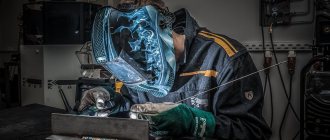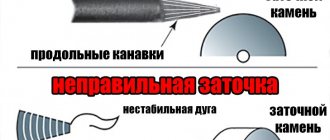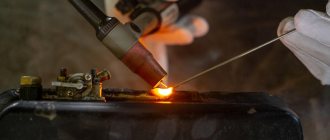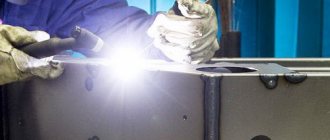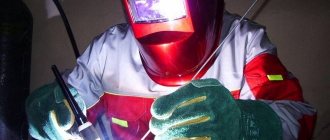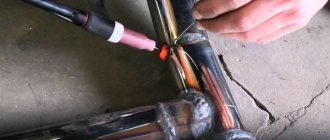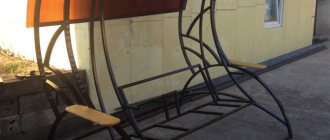No wonder there is an expression “cast iron is the bread of industry.” The first time this was said was at the beginning of the 20th century. Over the past century, many varieties have appeared, and the quality of processing has improved markedly. Today this material is widely used for the production of a wide variety of things, due to its high level of wear resistance. But over time, even such a durable metal begins to lose its qualities. Then welding using argon gas comes into play.
Previously, to achieve a high-quality seam for long-term use of products, it took a lot of effort, and the work was very hard. Today, the process is still difficult to implement, but now it has become available to home craftsmen.
Features of the technology of welded cast iron products
The connection of cast iron products is carried out in the same way as in the case of other metals. In this case, the structure of the weld itself is identical to the base material. Welding technology necessarily includes preheating followed by leisurely cooling.
When the cast iron parts being welded are in the preheating stage, the structure of the metal changes, which leads to the precipitation of graphite. The result of this is an increase in the plastic properties of the material. If welding is performed using a graphite electrode, this avoids metal impurities getting into the seam. In addition to it, special cast iron plates are used, as well as flux-cored wire.
At the end of TIG welding, the joined workpieces must be cooled. The difficulty of the whole procedure is to prevent a sharp drop in temperature - everything should take place gradually. Moreover, if you simply leave the parts at room temperature, it is not always possible to achieve the desired effect. It is for this reason that various insulating materials are used. They cover the workpieces and leave them to cool for some time. Or you can simply fill them completely with sand, which is used by many home craftsmen.
Cold procedure
In industrial conditions, the technique of cold welding of cast iron is actively used, which does not require preheating. There are several varieties, but three types are often used, based on the electrode materials:
- steel;
- non-ferrous metals;
- low carbon steel.
This variety is good because it significantly simplifies the production of cast iron products, immediately eliminating two stages. Accordingly, the cost will be lower. In addition, preheating requires the use of special equipment.
Connecting cast iron workpieces with argon using the cold method has one feature - the process must be carried out with a low current. This will prevent mixing of all elements in the welded joint. In addition, residual stress is removed from the metal, which usually destroys the weld. In addition, the gaseous environment acts as a certain protective barrier. The likelihood of cast iron becoming brittle is minimized.
Useful tips
Even following the above plan exactly does not guarantee that you will get the expected effect. Below are some recommendations from experienced welders:
- when processing material at home, any method of preheating the part is allowed;
- the maximum length of short seams should not exceed 30 mm;
- blows with a hammer to relieve stress should be performed gently and carefully to avoid cracking of the part.
The high quality of the resulting joint is the main reason for the popularity of argon welding of cast iron products. With proper experience, the process proceeds quickly, and when purchasing nickel filler rods instead of bronze or aluminum, the quality is high. The difficulties associated with the physical and chemical characteristics of cast iron are eliminated when welding is performed in an argon environment. However, this is achievable only if a number of conditions are met.
Did we miss any nuances when welding cast iron? In the comments to the article, you can share your opinion on this topic.
Preparatory stage
This procedure requires more careful and careful attention than when joining other metals. This is due to the qualities of cast iron itself - it is prone to destruction and cracking.
During preparation, the following operations are performed:
- The edges of the parts to be joined should be thoroughly cleaned of contaminants - dirt, rust, slag.
- Existing cracks are sawed off, otherwise it will close only at the top, and a weak structure will remain deep in the metal.
- The edges are cut along the entire length of the seam with bevels at an angle of 45°, and sharp edges are rounded. This measure ensures uniform heating.
- The products are placed on graphite pads, which avoid leakage of molten metal, and the products themselves will not be deformed.
If there are minor oil contaminants, they are removed with an organic solvent or burned out using a gas burner.
Materials and equipment used
To connect cast iron workpieces, you will need both appropriate materials and the main tool of the procedure - special equipment. Without all this, the work simply cannot be completed.
Filler material
This is a necessary paraphernalia for welding cast iron with argon, which you simply cannot do without, and therefore the choice of additives is of paramount importance. Cast iron rods are widely used. Moreover, those that do not have an external coating.
The most popular brands of additives for joining cast iron products in an argon environment are:
- “A” – corresponds to hot welding.
- “B” - indicates that it belongs to hot TIG welding using local heating of workpieces.
- “NCH-1” is a designation for connecting thin cast iron products using semi-hot welding.
- “NCH-2” – applicable to semi-hot welding of cast iron products with thick walls.
- “BCh, KhCh” – for a weld with high wear resistance.
It is also permissible to use nickel additives for argon TIG welding. The table below shows the brands of this type of filler material, listing their properties and composition.
| Brand | Mechanical properties | Chemical composition | ||
| Yield strength, Pa | Tensile strength, MPa | Elongation, % | ||
| OK TIGROD 19.82 | 800 | 500 | 35 | C |
| OK TIGROD 19.85 | 700 | 425 | 44 | C -67.0 |
| OK TIGROD 19.92 | 500 | 300 | 27 | C-0.02, Mn-0.4, Cu-0.1, Ti-3.0, Al-0.1, Ni ->93.0 |
The diameter of the filler rod is selected based on the thickness of the cast iron products - it should be half the size of the walls.
Equipment
An argon arc apparatus is used to weld cast iron products in a gas environment. This type of equipment includes two welding modes:
- electric;
- gas.
As a result, the permanent connection acquires the necessary quality for further long-term operation. At the same time, you can find a variety of automatic or semi-automatic models on sale.
A semi-automatic machine using an inverter produces a high-quality seam. However, before work, the workpieces must be preheated to a temperature of at least 300 °C. Next, all that remains is to make the necessary settings - set the current strength, additive feed rate and current. The operating instructions for the equipment contain information regarding the voltage that is provided for a particular case.
When using automatic devices, preference is given to powder additives. A person’s participation in the welding process is limited to installing the apparatus at the welded joint, and he can do the rest on his own.
Applications of argon arc welding
The use of argon non-consumable electrode welding is mainly aimed at alloy steels, their compounds and non-ferrous metals, titanium and aluminum alloys. Due to the good quality and shape of the welds, the precise depth of metal penetration, argon arc welding, a video of which can be seen here, is successfully used for welding thin sheets of metal with access to one side of the surface of the product.
The development of various designs of welding machines has allowed this type of welding to become widespread for welding pipe joints, also called orbital welding.
The use of argon consumable electrode welding is not so extensive. As a rule, this is welding aluminum to stainless steel.
Welding procedure for cast iron
To obtain a high-quality weld, you must strictly adhere to a certain technology:
- First of all, prepare the products to be connected.
- Set the welding mode.
- Arm yourself with a torch with your right hand, and take the filler wire with your left.
- Gas from the burner should be supplied 20 seconds before the start of the process.
- A distance of 2 mm should be maintained between the seam and the electrode.
- Turn on the device - voltage is immediately applied to the electrode, which causes an electric arc to occur.
- Argon is supplied to the area of the welded joint. The additive will begin to melt and, in liquid form, will begin to fill the void between the products being joined.
- After forming the weld, you need to allow the workpieces to cool.
Only by adhering to technology, as well as observing safety precautions, can you obtain a high-quality welded joint that will last a long time. And thanks to argon, the seam will not become covered with cracks and pores.
For clarity, you can find suitable videos on the Internet where you can see that someone is doing a good job. For example, here you can see how a process is performed using argon.
Important Tips
When performing welding work in an argon environment, you should not discount a number of points:
- Half of the entire procedure is preparation, and the quality of the welded joint depends on it.
- The cast iron products to be joined must be preheated using any available means.
- The seam should be done in short sections of 25-30 mm.
- Smooth feed of filler wire will avoid spatter.
- During welding, the torch must be constantly moved without holding it in place. Otherwise, the metal will overheat, which will lead to strong evaporation of carbon. Weldability will deteriorate, and the hardness will not be throughout the entire seam, but within local limits.
- It is optimal to carry out welding in the lower position, which will prevent leakage of molten metal from the weld.
Sometimes even a high-quality seam may exhibit residual stress. This has a negative impact on the durability of the workpieces. You can remove it by tapping the already cooled seam with a hammer along its entire length.
Disadvantages of argon arc welding
It is impossible to conduct training in argon arc welding without mentioning its disadvantage, which is the insufficiently high productivity with manual processing. Automatic welding is not suitable for making short and unstructured seams.
More on this topic on our website:
- Welding cast iron with an electrode - process video Cast iron is a special iron-carbon alloy that has a high carbon content (2.14%). Due to this, in comparison with other steels, it is in a free state. TO…
- Which welding machine for welding aluminum and duralumin should a beginner choose? The process of welding aluminum and duralumin has several features that must be taken into account both when working and when selecting equipment for it. Firstly, aluminum is...
- Argon welding - video on how to properly perform argon welding Before starting work, you should carefully review “Argon welding. Video" in order to understand the advantages of its use, the nuances of the process itself, as well as the most common mistakes that...
- Manual arc welding - video and principle of operation of the welding machine for beginners. The RDS method is the most common and accessible method of welding with a piece coated electrode. The manual arc welding video instructions clearly show that this method is different...
Share a link to this material with your friends on social networks (click on the icons):


